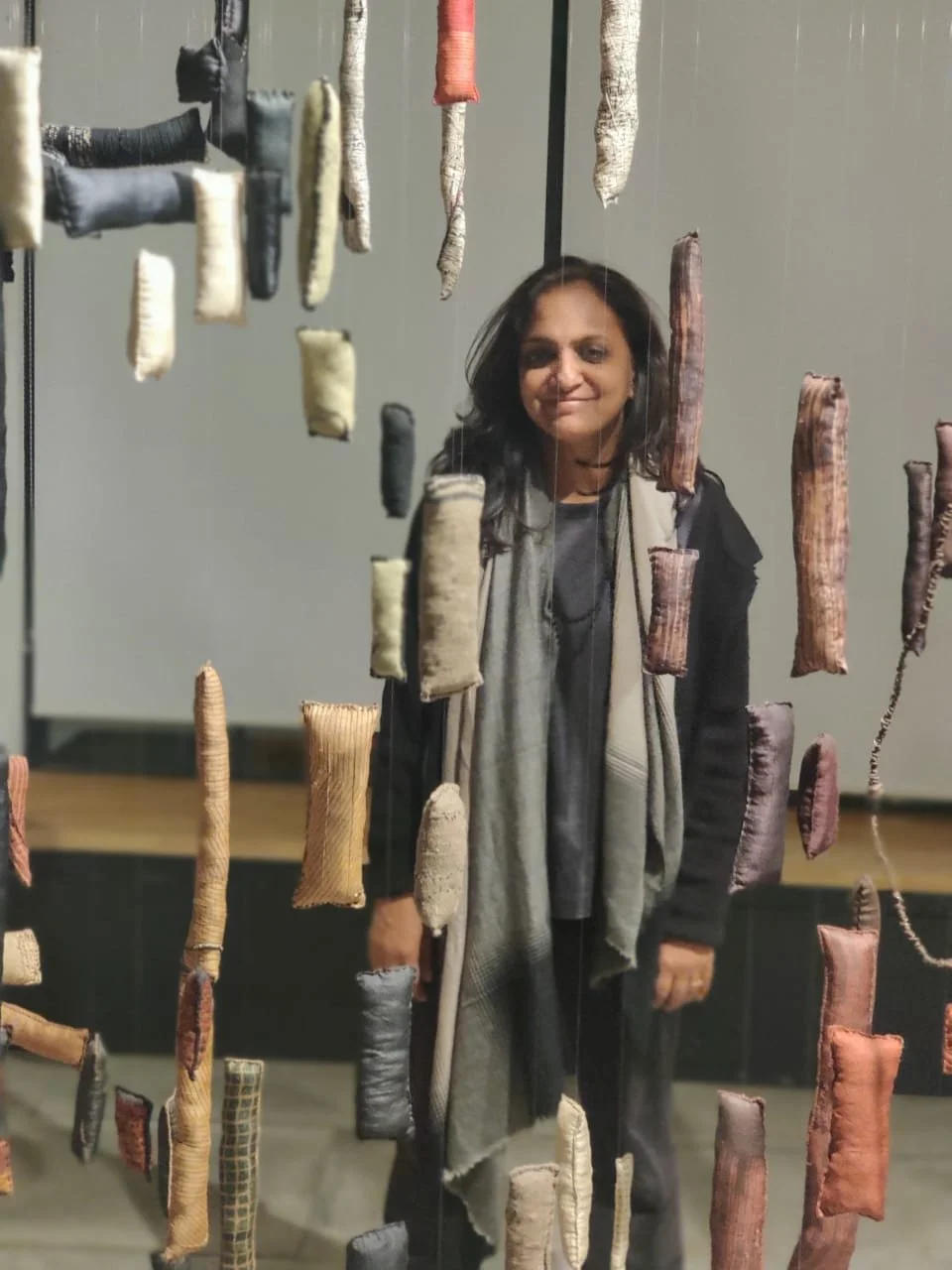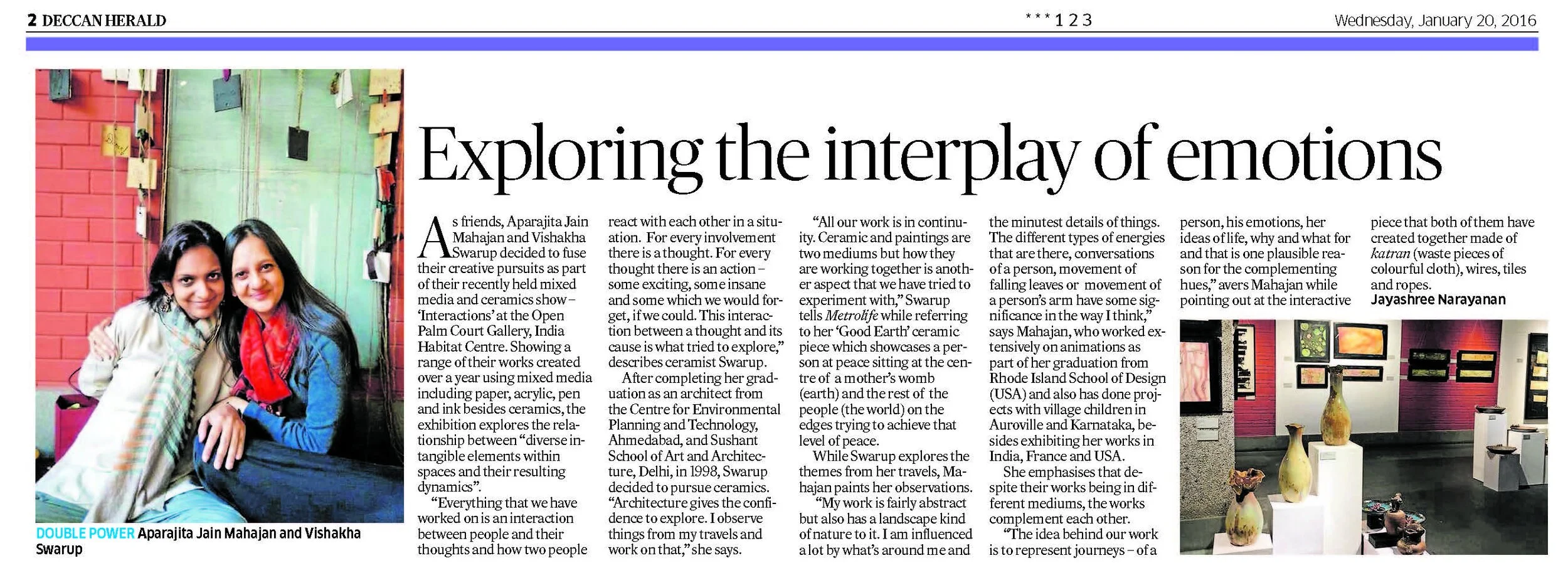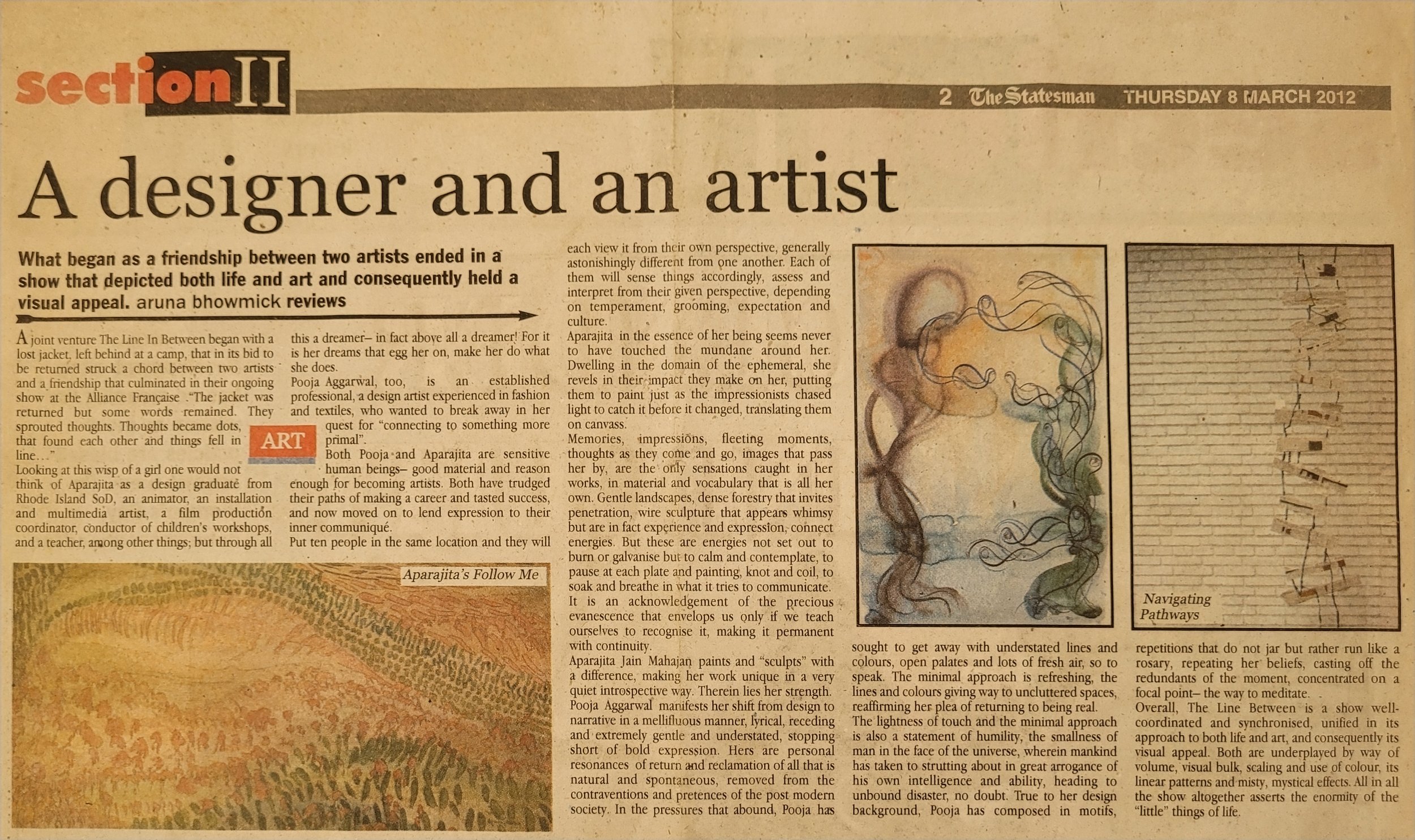
PRESS ARTICLES
Platform Magazine, 8th February 2020, by Unnati Saini
Tracing Memories
Aparajita Jain Mahajan
Humans may come and go but memories never leave. Such was the narrative behind RISD alumni Aparajita Jain Mahajan's exhibit Tracing Memories at the recently concluded group show Building Ruins. The thought provoking and deeply philosophical work by the artist made me wonder about the continued process of meaning-making that accompanies memory. The left-over material from her late mother's store stitched, knotted and stuffed with some her cherished moments, out there in the public space perphaps now to look for newer narratives to contain within itself. I asked the artist about everything that went behind the scenes. Excerpts as follows:
When and how did your romance with the arts begin?
I grew up in a home with a specific colour palette and aesthetic. Thinking visually was a natural result of the creative atmosphere that surrounded me in my late mother's work and home. The tactile nature of materials has always interested me. How a simple fabric and thread could be manipulated by human hands into creating something special; hearing stories about how my mother convinced her father to send her to JJ school of arts in the 60s; being immersed in nature while I studied in Rishi Valley - all these factors subconsciously led to my love for the arts.
What did the process of creating this artwork look like? Did you have any end picture in mind when you started?
Once I read our curator's brief (Building Ruins), I instantly knew I was going to work with Haveli katrans and my unfinished art works to create an installation “Tracing Memories”. By using these materials that got frozen in their paths each having their own story, to create a connection between the past and the present. I have a very instinctive and subconscious way of working. The first step was to intuitively sieve through the vast amounts material and separate it into groups of what was relevant. Amongst researching forms, doodling shapes, jotting down thoughts, I navigated between the materials and what I was visualising. Soon the Katran turned to shapes. The process of deciding the threads was nostalgic as I found myself working in the same way as my mother did in her apparel work at Haveli. There is a lot of detailing using mark making with stitching. When all the components were complete, I pre-planned the layout of the installation on paper by marking and numbering them. The overall form of the work from a trail on the floor to it climbing the walls and ultimately floating through space being held by delicate yet very strong lines was an interesting and organic progression of my thoughts.
While Tracing Memories seems like a deeply personal project for you, what did you want the audience to take away from it?
As the audience interacted with ‘Tracing Memories’, I wanted them to travel with the movement, pause, experience the colours, think through the details and weave their own interpretation and create their own story. For those familiar with Haveli Textiles (my late mother's pioneering apparel store 1987-2015), knowing these textiles from another context triggered their own set of memories and emotions.
How did your artwork connect to the larger idea of Building Ruins?
Few years ago, when Haveli closed it left me with numerous boris & potlis of exquisite katran, remnants of my mother’s legacy, awaiting to resume the journey that was cut short abruptly. Also lay in my studio, unfinished works of art that feared oblivion and yearned to be breathed back to life. “Tracing Memories” gives the forgotten pieces a renewed destiny: woven, stuffed, stitched and knotted together. It fulfils their longing to be part of a meandering trail to new destinations, a second chance for ruins to reincarnate.
The show was multidisciplinary. What do you personally think is the relevance of this intermingling of different medium in contemporary times?
The juxtaposition of thoughts answering the same brief being expressed in an array of materials is extremely intriguing. Use of various medium with the underlying thought of second chances, of finding light where you may find darkness, of transforming a ruin meanders through life has a relevance in today’s context. What gets left behind in various states of being, this gives them a renewed destiny!
Finally what's coming up next for you?
I want to create a series reflecting the idea of meeting, conversing, smiling, arguing, laughing with strangers weaving these unknown connections in mixed media artworks. The "where" of the interaction sets the tone for these exchanges of energy between people.
Text Unnati Saini
Elle India, 18th February, 2020, by Annesha George
Aparajita Jain Mahajan stitches fragments of memories through her art
For Aparajita Jain Mahajan, becoming an artist was the most organic decision she has ever made. Having grown up playing in her mother’s garment store, Haveli, which revived ethnic Indian textiles, she was always surrounded by artisans and painters. At her latest exhibition, Tracing Memories, which was a part of the group show Building Ruins (organised by the alumini club of the Rhode Island School of Design), she has revisited those childhood memories using leftover materials from the store she loved so dearly. ELLE spoke to her about the creative process that went into the meticulously created work of art.
ELLE: A lot of your love for art stems from the influence your mother had in your life. Tell us a little about it.
Aparajita Jain Mahajan: I grew up with stories of my mother’s love for art and how she took a big stand to get to go to art school. I was always encouraged to create with my hands and I spent a lot of time discussing my work with my mother as well. These discussions and thoughts have often found their way into my work.
ELLE: When did you realise you wanted to take it up as a career?
AJM: I never looked at it like a job. I think I subconsciously decided that this was the path I was going to pick. I’ve always just gone with flow. My first job was as an animator. I’ve created animations for the Gandhi exhibit which have permanent residence at The Birla House.
ELLE: How has being an animator helped you as an artist now?
AJM: It has heavily influenced the way I conceptualise things in my head now. I break down everything into frames and keep every little mark I make, every little movement, in mind because they all tend to have a role to play. Even while ideating for a piece, I like to write down keywords that come to my mind and then build on the thought.
ELLE: What inspired your last exhibit, Tracing Memories for the show Building Ruins?
AJM: To me, the idea revolved around second chances. Ruins are left behind so that you can weave another story from it. So I decided to use two ruins that were part of my life. One was the katran that was leftover from my mother’s store and the other was my unfinished work that couldn’t be completed because I was moving cities. I stitched, knotted and stuffed the katran into different shapes and decided to suspend them. I’ve always wanted to create art that involved a 3D effect or some form of suspension, so I’ve ticked that off my list.
Aparajita Jain Mahajan stitched, knotted and stuffed the katran that was leftover from her mother’s store
ELLE: What’s been the best feedback you’ve got for it?
AJM: An old friend’s mother came to see my exhibition and as she discussed the art with me, I felt a deeper connection with the piece. I felt like I understood it better. I realised a lot of the processes like knotting the katran were just spontaneous movements by me. And I also realised that all my works were an extension of my older works. The detailing, the shapes, the flow were all co-related and although each piece of this exhibit told different stories if you viewed them from different angles, they are all connected.
ELLE: Which is the next project you are excited for?
AJM: I have this series in mind which will be created with about a hundred small pieces and will revolve around the concept of interacting with strangers. It will bring out the aspect of sharing space with the unknown, an abstract depiction of how energies interact. I am very kicked about translating these thoughts into art.
“Interactions”, Two person show at Open Palm Court, Habitat Center, New Delhi, India, 2016
“The Line In Between”, Two person show at Alliance Francaise in 2012, Curated by Elizabeth Rogers
The Hindu, 3rd March 2012
“A Train of Thought”, solo show, New Delhi, India, 2009







